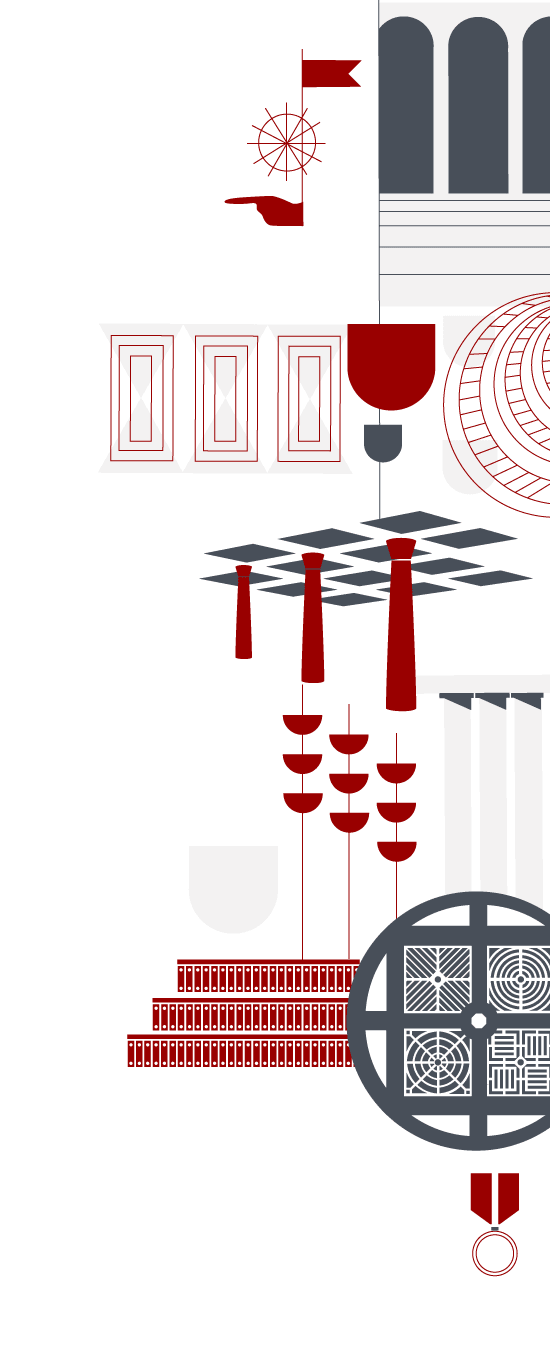
Eminent Alumni
Throughout the centuries many professors - scientists, jurists and literati - made Padua University a centre which irradiates culture all over Europe.
Scholars came from all over Europe and often started their own cultural institutions on their return home. To name a few:
- Nicolaus Copernicus - Polish astronomer
- Pietro d'Abano - physician and philosopher
- Marcantonio dalla Torre - Leonardo da Vinci's anatomy instructor
- Andreas Vesalius - Flemish anatomist
- Girolamo Fabrici d'Acquapendente - set up the permanent anatomy theatre still at Palazzo Bo in 1594
- Giovan Battista Morgagni - founder of Pathological anatomy
- William Harvey - discoverer of the circulation of the blood
- Count Giovanni Dondi - professor of Humanities and Petrarch's friend
- Pier Paolo Vergerio, humanist
- Elena Lucrezia Cornaro Piscopia - first woman in the world to graduate in a university, in 1678
- Thomas Penketh - English professor of Theology
- Vittorino da Feltre - lecturer in Rhetoric
- Demetrius Chalkondyles - Athenian professor of Greek
- Melchiorre Cesarotti - poet and translator
- Pietro Bembo and Torquato Tasso - poets
- Erasmus from Rotterdam - theologian and humanist
- Franciscus Skarina - the father of Belarusian literature
- the Polish poets Klemens Janicki and Jan Kochanowski, Ugo Foscolo - poet
- Giuseppe Tartini, musician and composer
- Giacomo Casanova, traveller, author
- Johann Georg Wirsung, anatomist - discoverer of the pancreatic duct ("duct of Wirsung")
...and many others
Twelwe Maestros
Enrico Bernardi (1841-1919). Ingenious inventor and pioneer of industry, Bernardi built the first Italian automobile in 1894: it
had three wheels, a four-stroke engine, and could reach a speed of 35 km/h. A working example with all its original parts is
conserved in the University of Padova Museum dedicated to this great inventor.
Massimilla Baldo Ceolin (1924-2011). Scientist and teacher of Physics, Ceolin was the first woman to be nominated to a
chair at the University of Padova (1963). Her research focused on elementary particles and the “weak interactions” responsible
for radioactive processes. Her studies on neutrinos contributed substantially to modern theories which interpret the oldest phases of the history of the Universe in an innovative way.
Norberto Bobbio (1909-2004). One of the greatest philosophers of law and political science of the 20th century, Bobbio taught at the University of Padova from 1940 to 1948. A supporter of the Partito d’Azione (Action Party) he was arrested by the fascist authorities in December 1943. His “neo-illuminism”, a theory favouring the opening up of dialogue and the rigorous use of reasoning, had a profound effect on Italian cultural life, making Bobbio one of the best-known and influential Italian intellectuals of the time. He was nominated a life senator.
Giuseppe Colombo (1920-1984). Professor of applied mechanics, Colombo has been described as the “master of celestial mechanics”. His studies led him to important discoveries, such as the exact movement of Mercury round the Sun. He spent long periods at prestigious institutions in the United States. It is to him that we owe the introduction of the “tethered system” applied to space structures and used by NASA during the Shuttle space flights.
Nicolaus Copernicus (1473-1543). Nicolaus Copernicus studied in Padova in the early 16th century, in contact with the doctor and scientist Girolamo Fracastoro. His De revolutionibus orbium coelestium, with its descrption of the heliocentric system (the planets revolve round the Sun) has also been known since then as the Copernican system, and is now considered to mark the birth of scientific revolution in the Western world.
Ugo Foscolo (1778-1827). A celebrated Italian poet and writer, Foscolo was one of the foremost men of letters between the
Neoclassic and Romantic periods. He followed the lessons taught by Melchiorre Cesarotti, a professor at the University of Padova, and translator of some of the works of Homer and of the Songs of Ossian. In 1795, Foscolo asked Cesarotti for his opinion of his first tragedy, “Tieste”.
Galileo Galilei (1564-1642). Together with Newton, Galileo is considered one of the fathers of modern science, for his momentous discoveries and his definition of proper scientific method. He stated that, in Padova, he had passed the best 18 years of his life, thanks to the great freedom of thought which the University of Padova allowed, protected as it was by Most Serene Republic of Venice.
Vincenzo Gallucci (1935-1991). Gallucci and his team carried out the first heart transplant in Italy, on November 14 1985. The Gallucci Heart Surgery Centre, one of the top centres for international transplant techniques, is dedicated to his memory.
Carlo Goldoni (1707-1793). One of the best comedy playwrights in Europe, Goldoni graduated in law from the University of Padova in 1731. After working as a lawyer, he devoted his energies to an enormous and highly popular series of comedies in Venetian dialect and Italian. Removed the tradition of the commedia dell’arte, his plays focus on text and personages, taken from episodes of daily life. Among his masterpieces are I rusteghi, Il campiello, and Le baruffe chiozzotte.
William Harvey (1578-1657). The great English doctor Harvey “discovered” the circulation of the blood. Although other
scientists before him had noted the phenomenon, Harvey was the first to describe it accurately. He studied at the University
of Cambridge and also in Padova, where he was a pupil of the doctor Girolamo Fabrici d’Acquapendente and the philosopher
Cesare Cremonini.
Tullio Levi Civita (1873-1941). Levi Civita graduated from the University of Padova, his native city, in mathematics. One of
his teachers was Gregorio Ricci Curbastro, with whom he later collaborated on tensor calculus, an essential point of reference
and basis of the mathematical structure of Albert Einstein’s general theory of relativity.
Cesare Musatti (1897-1989). Musatti further developed the experimental research lines of Vittorio Benussi, continuing the
work of the latter, with particular interest in the psychology of perception, testimony, suggestion and hypnosis. He was also a
prime figure in the development of psychoanalysis in Italy.


